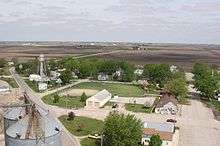Kamrar, Iowa
| Kamrar, Iowa | |
|---|---|
| City | |
 Location of Kamrar, Iowa | |
| Coordinates: 42°23′31″N 93°43′43″W / 42.39194°N 93.72861°WCoordinates: 42°23′31″N 93°43′43″W / 42.39194°N 93.72861°W | |
| Country |
|
| State |
|
| County | Hamilton |
| Area[1] | |
| • Total | 0.86 sq mi (2.23 km2) |
| • Land | 0.86 sq mi (2.23 km2) |
| • Water | 0 sq mi (0 km2) |
| Elevation | 1,122 ft (342 m) |
| Population (2010)[2] | |
| • Total | 199 |
| • Estimate (2012[3]) | 196 |
| • Density | 231.4/sq mi (89.3/km2) |
| Time zone | Central (CST) (UTC-6) |
| • Summer (DST) | CDT (UTC-5) |
| ZIP code | 50132 |
| Area code(s) | 515 |
| FIPS code | 19-40215 |
| GNIS feature ID | 0458020 |
Kamrar is a city in Hamilton County, Iowa, United States. The population was 199 at the 2010 census.
History
Kamrar was platted in 1881.[4] It was named for Judge J. M. Kamrar, a local attorney.[4] A post office has been in operation in Kamrar since 1882.[5]
Geography
Kamrar is located at 42°23′31″N 93°43′43″W / 42.39194°N 93.72861°W (42.391944, -93.728715).[6]
According to the United States Census Bureau, the city has a total area of 0.86 square miles (2.23 km2), all of it land.[1]

Demographics
| Historical populations | ||
|---|---|---|
| Year | Pop. | ±% |
| 1900 | 223 | — |
| 1910 | 262 | +17.5% |
| 1920 | 256 | −2.3% |
| 1930 | 286 | +11.7% |
| 1940 | 288 | +0.7% |
| 1950 | 261 | −9.4% |
| 1960 | 268 | +2.7% |
| 1970 | 243 | −9.3% |
| 1980 | 225 | −7.4% |
| 1990 | 203 | −9.8% |
| 2000 | 229 | +12.8% |
| 2010 | 199 | −13.1% |
| 2014 | 193 | −3.0% |
| 2015 | 198 | +2.6% |
| Source:"American FactFinder". United States Census Bureau. and Iowa Data Center Source: | ||
2010 census
As of the census[2] of 2010, there were 199 people, 82 households, and 45 families residing in the city. The population density was 231.4 inhabitants per square mile (89.3/km2). There were 95 housing units at an average density of 110.5 per square mile (42.7/km2). The racial makeup of the city was 96.5% White, 2.0% Asian, and 1.5% from two or more races.
There were 82 households of which 29.3% had children under the age of 18 living with them, 45.1% were married couples living together, 6.1% had a female householder with no husband present, 3.7% had a male householder with no wife present, and 45.1% were non-families. 32.9% of all households were made up of individuals and 12.2% had someone living alone who was 65 years of age or older. The average household size was 2.43 and the average family size was 3.31.
The median age in the city was 40.5 years. 26.1% of residents were under the age of 18; 3.4% were between the ages of 18 and 24; 26.5% were from 25 to 44; 25% were from 45 to 64; and 18.6% were 65 years of age or older. The gender makeup of the city was 50.8% male and 49.2% female.
2000 census
As of the census[8] of 2000, there were 229 people, 91 households, and 66 families residing in the city. The population density was 275.9 people per square mile (106.5/km²). There were 100 housing units at an average density of 120.5 per square mile (46.5/km²). The racial makeup of the city was 95.63% White, 1.31% Native American, 1.31% Asian, and 1.75% from two or more races. Hispanic or Latino of any race were 0.44% of the population.
There were 91 households out of which 34.1% had children under the age of 18 living with them, 56.0% were married couples living together, 12.1% had a female householder with no husband present, and 26.4% were non-families. 24.2% of all households were made up of individuals and 13.2% had someone living alone who was 65 years of age or older. The average household size was 2.52 and the average family size was 2.93.
In the city the population was spread out with 26.2% under the age of 18, 7.4% from 18 to 24, 29.7% from 25 to 44, 18.8% from 45 to 64, and 17.9% who were 65 years of age or older. The median age was 37 years. For every 100 females there were 112.0 males. For every 100 females age 18 and over, there were 108.6 males.
The median income for a household in the city was $37,188, and the median income for a family was $41,071. Males had a median income of $30,500 versus $21,964 for females. The per capita income for the city was $15,892. About 3.0% of families and 3.1% of the population were below the poverty line, including none of those under the age of eighteen or sixty five or over.
References
- 1 2 "US Gazetteer files 2010". United States Census Bureau. Retrieved 2012-05-11.
- 1 2 "American FactFinder". United States Census Bureau. Retrieved 2012-05-11.
- ↑ "Population Estimates". United States Census Bureau. Retrieved 2013-05-23.
- 1 2 Chicago and North Western Railway Company (1908). A History of the Origin of the Place Names Connected with the Chicago & North Western and Chicago, St. Paul, Minneapolis & Omaha Railways. p. 89.
- ↑ "Hamilton County". Jim Forte Postal History. Retrieved 21 March 2015.
- ↑ "US Gazetteer files: 2010, 2000, and 1990". United States Census Bureau. 2011-02-12. Retrieved 2011-04-23.
- ↑ "Census of Population and Housing". Census.gov. Retrieved June 4, 2015.
- ↑ "American FactFinder". United States Census Bureau. Retrieved 2008-01-31.